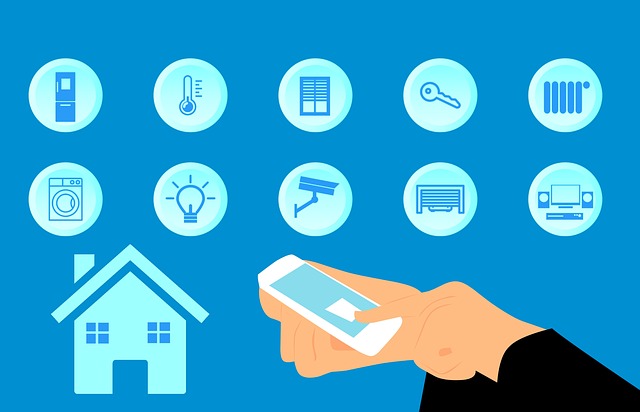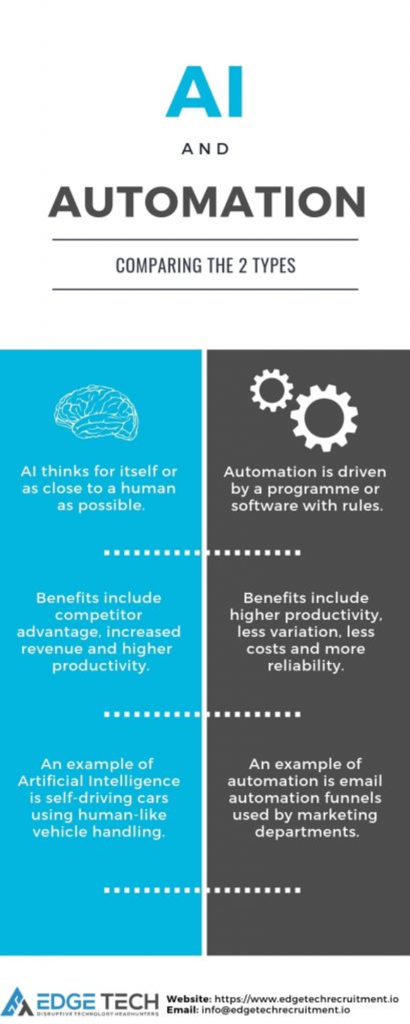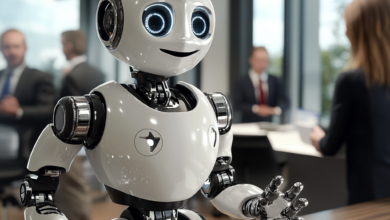
What’s the Difference Between Artificial Intelligence and Automation?
How are artificial intelligence (AI) and Automation different? Don’t they both offer options of hands-free, robotic style design?
Often times we use automation and artificial intelligence interchangeably, but they are very different. We think of them all as just “robots” while not fully understanding what is powering the robot’s intelligence.
However, there is a pretty big difference between Artificial Intelligence and Automation.
It’s almost like comparing apples to oranges.
There are automated machines and there are Artificial Intelligent machines, however, some automated machines can be powered by artificial intelligence.
So, what is the simple difference?
- Automation is driven by a programme or software with rules and simple programming.
- Artificial Intelligence is designed to think for itself or as close to a human as possible.
Automation is virtually everywhere.
It is in our factories, homes, and businesses.
Automation was designed to take repetitive tasks away from needing human touch.
Taking these tasks away frees up the human for more important things.
After all, if a company had to personally send out their entire e-mail list one at a time, it probably would never get done. And, most of the time if a task is automated, it has less chance of failing.
Putting in the same screw over and over again, for example, is a task for automation. And, automation probably does it much better than a human.
The end result is a process that’s more efficient, has less variation, and is less costly to get more done.
Automation Completes Tasks Quickly and Efficiently
Automation can be used for simple tasks and for complex tasks, but it’s still not Artificial Intelligence. Every business uses automation in some way or another as it’s everywhere in our society.
So, essentially, automation is a machine that reads a programme and follows the directions. It cannot determine anything or think, but it follows what it’s told.
These systems are used all around us already and are highly useful. They assist in assembly lines as well as filtering leads and e-mails for businesses.
Automation can get complex if there are many steps to programming.
However, it is still just programming, and the machine is not thinking.
It’s not thinking on its own, but just following directions. Getting tasks done along the way.
An Example of Automation:
An automated e-mail goes out to all clients asking if they would like to take a survey.
Some will say “yes”, some “no” and some won’t answer.
The automation tool will put the “yes” people in another e-mail with the survey attached. It will then put the “no” people in another thanking them for their time. The people that ignored may get a follow up with a simple, “Hey, since you may have missed the first e-mail.” sort of thing.
This automation helps gather data on clients. It then automatically sends them e-mails that are appropriate.
Say, the “yes” people filled out the survey and you wanted to offer a thank you. The programme can sort out just the people that filled it out. And, that cycle begins again.
Artificial Intelligence Is Not Just Crazy Robots
Artificial Intelligence is a very smart robot that can “think” for itself. We’ve all heard of at least one robot movie where the robots are out to destroy the Earth.
Well, that is one form of artificial intelligence. It is made to try to mimic what humans would do, think or say and it’s all on its own.
It has the ability to learn very rapidly and form these “thoughts”, but at the same time, this rapid learning is also its flaw.
This allows it to easily be “fed” wrong information quickly, which would provide worthless output.
Artificial intelligence works well with things such as credit card fraud. The credit card company inputs all the information into the robot and so it has the transactions, dates, times, and amounts. When something comes up that looks out of the ordinary, it can flag it. This is just one example of a simple task that artificial intelligence is helping us every day.
So, before you get freaked out about artificial intelligence, remember, it’s already working and helping consumers and businesses every day. It’s not just robots out to take over the world.
“AI is capable of vastly more than almost anyone knows and the rate of improvement is exponential.” – Elon Musk
Artificial Intelligence Is The Future
Smart homes and self-parking cars use AI. Its uses are exploding as our workplaces are becoming more and more in demand for data.
As the world continues to interconnect, it’s only going to be used and needed more and more.
Data is coming in from all places as well.
People are, essentially, always walking around with a computer in their hands.
This is the modern world, and this isn’t changing anytime soon.
To keep up with the demands of all this data, AI systems are put into place. Customer Service is one area that almost all businesses use some form of AI.
This helps them to filter their clients to the appropriate channels. The idea is to make the business more efficient and save money while keeping customers happy.
Another way to look at Artificial Intelligence and Automation is like this:
- Artificial Intelligence understands data and analyses it.
- Automation collects data and uses its programming to analyse it.
Artificial Intelligence for Business
Artificial Intelligence is fed huge amounts of data to analyse. This helps businesses know many things about their clients, the demand and supply chain and so much more.
With these large amounts of data, they can adjust their systems to work as they should more efficiently. Artificial intelligence is the future of business.
Combining AI, as well as Automation, is where the true power for companies can come into play.
Imagine something that can consume large amounts of data and write the automation programme for you? Think of the time that could save.
The power a company would have with machines that could collect huge amounts of data.
That collected data could then be intelligently put into something that could easily be understood at a glance.
Graphs and charts about how many people do various tasks for example. That’s where this is going.
That is the future of business and automation.





One Comment